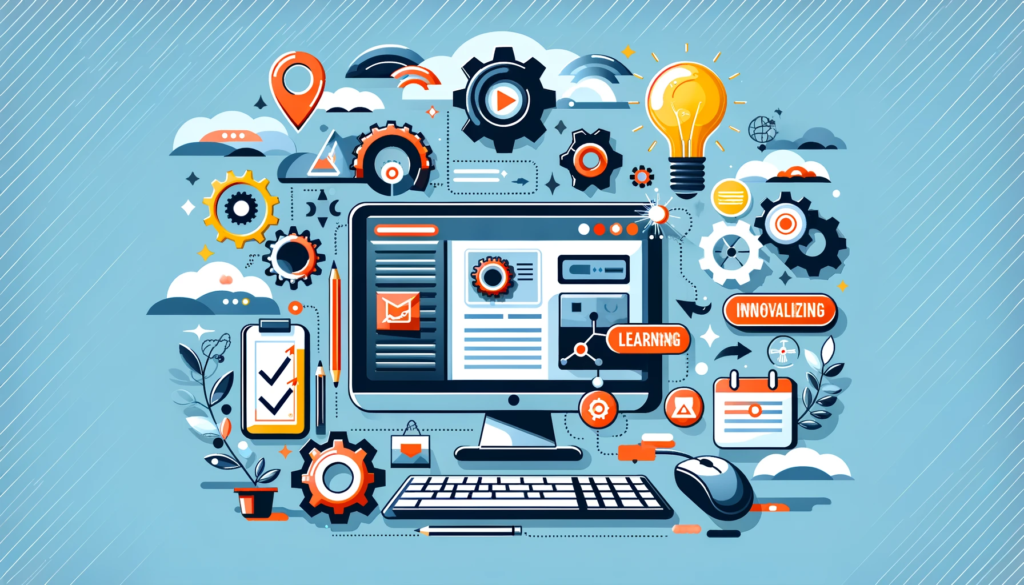
Leveraging Digital Solutions for Productivity
Embracing digital solutions can significantly enhance productivity and efficiency in both personal and professional environments. With advancements in technology, including Artificial Intelligence (AI), mundane tasks can be automated, leading to increased productivity and improved efficiency within teams and organizations (Calendar).
Table of Contents
Impact of Digital Renovation on Productivity
Digital renovations have been widely adopted and have significantly impacted productivity levels across various industries. According to Forbytes, 52% of companies worldwide reported an increase in worker productivity, 49% saw better performance, and 46% experienced improved customer experience after digital renovation.
Technology plays a crucial role in improving productivity and time management. Physical hardware such as computers, smartphones, tablets, and software protocols like cloud technology, cybersecurity infrastructure, and digital calendars can contribute to enhanced productivity.
Moreover, technology enables open communication channels within organizations, breaking down physical barriers and facilitating collaboration amongst teams. It also aids in improving data analysis and collaboration, providing organizations with valuable information to understand market trends, customer demands, and competitor performance.
Success Stories of Companies Using Digital Solutions
Several companies have successfully leveraged digital solutions, leading to improved productivity and efficiency. Here are a few notable examples:
- Domino’s Pizza: The pizza delivery company integrated AI and Machine Learning to process large volumes of data and automate order fulfillment.
- Michelin: The tire manufacturer uses AI-powered data circulation and collaborative robots to streamline manufacturing and improve the client experience.
- Walmart: The retail giant invested over $11 billion in tech renovation, including partnering with leading tech companies, strengthening their social media presence, modernizing the supply chain and inventory management, and integrating AI-powered data analytics and blockchain for better traceability (Forbytes).
- Nike: The sports apparel company moved away from wholesale and built an ecosystem of digital channels to directly connect with their clients and provide personalized experiences.
- Tesla: The electric vehicle manufacturer introduces software updates over the air, enables online car purchases, and plans to integrate AR technology into the manufacturing process to redefine how people see cars and their functions.
These success stories demonstrate the transformative potential of digital solutions in boosting productivity. By leveraging technology, individuals and organizations alike can achieve their goals more efficiently and effectively.

Enhancing Team Productivity with Technology
In an increasingly digital world, leveraging technology to enhance productivity is key. The integration of various digital tools in the workplace has been shown to increase efficiency and improve performance.
Role of Artificial Intelligence in Automation
Artificial Intelligence (AI) is a revolutionary technology that has the potential to transform the way teams and organizations operate. AI has the ability to automate mundane tasks, allowing team members to focus on more critical aspects of their work. This contributes to an increase in productivity and overall team efficiency (Calendar).
Incorporating AI technology into workflows can significantly reduce the time spent on repetitive tasks. From managing emails to scheduling meetings, AI can automate a range of operations that traditionally take up valuable time. By embracing AI, organizations can free up their team’s time, allowing them to concentrate on strategic initiatives and creative problem-solving.
Benefits of Technology in Data Analysis
Another area where technology significantly impacts productivity is data analysis. Technology provides organizations with valuable information to understand market trends, customer demands, and competitor performance. This leads to more tailored solutions, efficient customer engagement, and informed decision-making (Calendar).
Moreover, technology enables open and direct communication channels within organizations, breaking down physical barriers. This facilitates collaboration among teams, further driving productivity. With the aid of technology, teams can share and access data in real-time, leading to improved cooperation and quicker decision-making.
| Benefits of Technology in Data Analysis | Percentage of Companies Benefiting |
|---|---|
| Improved Productivity | 52% |
| Better Performance | 49% |
| Enhanced Customer Experience | 46% |
Data from Forbytes
By fully embracing these digital solutions, individuals and teams can experience a significant improvement in their productivity levels. To learn more about how technology can help improve time management, visit our article on digital tools for time management. For more on how technology can enhance overall wellbeing, explore leveraging technology for wellbeing.

Overcoming Productivity Challenges
A shift towards a hybrid model of work and remote teams is currently being observed in businesses, leading to challenges in maintaining productivity. This makes it crucial to implement digital solutions that can enhance productivity and streamline processes.
Importance of Digital Productivity Solutions
Digital productivity solutions play an integral role in maintaining business productivity, especially in a remote or hybrid work environment. With teams dispersed across multiple locations, it becomes imperative to use digital tools that can bridge the gap and facilitate efficient work processes.
Implementing these solutions is not an easy task, nor is it a cheap investment. Intensive transformation efforts can take years to accomplish, and during that time, customer needs might change. It’s crucial to be proactive and plan for agility when adopting new digital technologies. Scope creep can push back deadlines and add to the cost of the transformation project. Therefore, a sound strategy and careful planning are essential to navigate these challenges efficiently.
However, successful digital transformation can result in improved productivity, cost savings, and enhanced customer experience. For instance, Internet Brands® subsidiary Baystone Media implemented a Digital Adoption Platform (DAP) from Whatfix to drive product adoption for its healthcare businesses. This resulted in a 10% decrease in inbound calls and a 4.17% decrease in support tickets, improving productivity and enhancing service for its clients.
Improving Remote Teamwork with Technology
Improving remote teamwork with digital tools involves several aspects. For instance, using online file storage systems and content collaboration platforms like Zoho WorkDrive can enhance remote teamwork. These platforms allow creating folders based on teams and projects, defining roles, and facilitating virtual collaboration on documents.
Effective communication in a digital workplace involves passing on email hygiene tips, integrating email and virtual meeting software, and fostering real-time virtual collaboration. This can help break down communication barriers caused by remote work.
Monitoring team KPIs, motivating team members, assigning tasks, and sharing relevant business objectives through project management and agility tools can help managers ensure their team stays ahead of deadlines. This leads to improved productivity in a remote or hybrid work model.
Companies like Amazon and Tesla have been successful in leveraging technology for improving productivity. Amazon extended its B2C model to embrace B2B transactions, aiming to improve the customer experience. On the other hand, Tesla uses connected car technology and over-the-air software updates to enhance customer experience, enable cost savings, and reduce carbon emissions.
In conclusion, overcoming productivity challenges in the current work scenario requires embracing digital solutions. These tools offer a plethora of benefits, from streamlining communication and collaboration to enhancing team productivity. For more insights on improving productivity with digital tools, explore our articles on digital solutions for productivity and improving efficiency with technology.

Tools for Improved Productivity
In the quest for improving productivity, digital tools play an essential role. They not only streamline our work processes but also free us from monotonous tasks, enabling us to focus on more important tasks. In this section, we will explore two categories of tools: AI-Powered productivity tools and the most popular productivity tools in 2024.
AI-Powered Productivity Tools
Artificial Intelligence (AI) has undeniably revolutionized the way we work, making our tasks easier and more efficient. Here are some AI-powered tools you can consider to boost your productivity:
- Zapier: Zapier offers an Automation Platform with AI chatbot capabilities that allow users to create custom AI chatbots and automate tasks without coding. It also provides templates, such as a to-do list bot template, to help users break down goals into actionable tasks (Zapier).
- ChatGPT: Powered by OpenAI’s GPT-3 and GPT-4 models, ChatGPT is a popular AI chatbot that is flexible and easy to use. It can be integrated with Zapier to access its power from within other apps.
- Grammarly: As a widely used AI-powered grammar checker and rewording tool, Grammarly helps users improve their writing by offering suggestions to simplify complex phrases and improve tone.
- Descript: This AI-powered video editing tool transcribes videos into a script and allows users to edit the text script, automatically trimming the video accordingly (Zapier).
- DALL·E 3: An image generator by OpenAI, DALL·E 3 can create interesting and visually appealing images based on text prompts. It can be integrated with Zapier to automatically create images from various sources (Zapier).
Popular Productivity Tools in 2024
In 2024, the landscape of productivity tools continues to evolve, offering a multitude of options for teams and individuals alike. According to Simplilearn, some of the top productivity tools include:
- ProofHub for project management
- nTask for team collaboration and task management
- Infinity for keeping teams in sync
- GanttPro for online Gantt chart software to track work progress
- Calendar, HubSpot’s Marketing Hub, Slack, and Shift for enhancing productivity and efficient workflow.
Time-tracking tools like Toggl, Harvest, Paymo, and Everhour are recommended to help individuals and teams optimize time management, track task progress, and reach project goals efficiently. These tools provide features such as real-time tracking, reporting, and invoicing, contributing to improving overall team performance.
Note-taking apps like Evernote, Microsoft OneNote, Simplenote, and Box Notes are suggested for organizing, sharing, and storing notes effectively. These apps facilitate real-time collaboration, enabling users to work efficiently on projects and share ideas with team members without compromising security.
By integrating these tools into your work routine, you can step up your productivity game. To learn more about leveraging digital solutions for productivity, check out our article on digital solutions for productivity.

Time Management and Efficiency
In the digital age, time management and efficiency are key factors in improving productivity with digital tools. This section will debunk the myth of multitasking and discuss the importance of time calculators in enhancing productivity.
The Myth of Multitasking
The illusion of multitasking, often seen as a digital age “superpower”, is linked to distractions, poor time management, and loss of productivity (eLearning Industry). Studies have found that digital natives switch between different forms of digital media approximately every minute. This frequent switching decreases emotional investment in activities and leads to poor time management.
Contrary to popular belief, multitasking tends to lower productivity instead of enhancing it. In a bid to juggle multiple tasks simultaneously, individuals often find themselves unable to make significant progress in any of the tasks. Therefore, it’s crucial to debunk the myth of multitasking and focus on strategies that genuinely enhance productivity, such as leveraging technology for wellbeing and efficiency.
Importance of Time Calculators
One such strategy is the use of time calculators to enhance time management skills. A time calculator enables individuals to keep track of their production, thereby improving time management and productivity. By providing a clear view of how time is spent, these tools can help identify areas of inefficiency that need to be addressed (eLearning Industry).
Beyond individual use, technology-enabled tools that save a significant amount of time contribute to improving overall efficiency and productivity within businesses. Companies rely on cloud systems, computer technology, and online calendars to ensure project completion. These online calendars, integrated with email clients and scheduling apps, have surpassed manual to-do lists in helping individuals manage their time effectively. They assist in planning the day, scheduling events, and avoiding unnecessary interruptions. These tools are beneficial for both individual and group activities, and proper training is essential to maximize their effectiveness.
When integrating new time management tools or apps into your routine, it’s important to be authentic with your responses and offer specific examples. Adaptability and resourcefulness are traits that employers value in their candidates (IIENSTITU).
In conclusion, by debunking the myth of multitasking and leveraging digital tools like time calculators, individuals can enhance their time management skills, leading to higher productivity and improved efficiency with technology.

Integrating New Time Management Tools
When it comes to improving productivity with digital tools, one must not overlook the significant role of time management tools. These tools, powered by modern technology, can significantly impact how effectively individuals and teams utilize their time. In this section, we’ll look at two ways to integrate new time management tools into your routine: the Pomodoro Technique and project organization tools.
Implementing the Pomodoro Technique
In the realm of time management, the Pomodoro Technique stands as a popular method for improving productivity. This technique involves working in focused bursts of 25 minutes, followed by short breaks. This can greatly enhance productivity by allowing individuals to work intensively without succumbing to burnout. To implement this technique digitally, you could use an app like the Tomato Timer (IIENSTITU).
The Pomodoro Technique provides structure to your workday, helping you to stay focused on the task at hand while also ensuring you take necessary breaks. It’s a great example of an analog productivity method being translated into a digital format. For more on this and other digital tools for time management, visit our dedicated section.
Utilizing Project Organization Tools
Another aspect of improving productivity with digital tools is project organization. Digital tools like Trello can be instrumental in managing tasks and enhancing project organization. Trello’s visual nature and task management features can greatly improve efficiency. Whether you’re managing a personal project or collaborating with a team, project organization tools can streamline the process and help ensure all tasks are completed in a timely manner.
It’s important to remember that when integrating new time management tools or apps into your routine, employers value adaptability and resourcefulness. Always be willing to explore new tools and techniques that can improve your productivity.
Technology-enabled tools that save significant amounts of time contribute to improving overall efficiency and productivity. Businesses rely on cloud systems and computer technology to ensure project completion, while individuals increasingly use online calendars over manual to-do lists to manage their time effectively.
By embracing the power of digital solutions for productivity, you can level up your productivity game and improve your overall wellbeing by leveraging technology.

